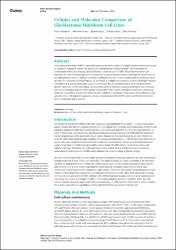Cellular and Molecular Comparison of Glioblastoma Multiform Cell Lines
Citation
Demircan T, Yavuz M, Kaya E, et al. (June 29, 2021) Cellular and Molecular Comparison of Glioblastoma Multiform Cell Lines. Cureus 13(6): e16043. DOI 10.7759/cureus.16043Abstract
Glioblastoma multiform (GBM) is one of the most severe tumor types. It is highly invasive and characterized as a grade IV neoplastic cancer. Its resistance to chemotherapy-temozolomide (TMZ treatment)-in combination with tumor treating fields (TTFields), limits the cure of GBM. Therefore researchers are searching for new treatment options to increase the length of recurrence time and improve overall survival for GBM patients. Several cell lines have been established and are in use to understand the molecular basis of GBM and to test the developed drugs. On one hand, it is highly advantageous to utilize multiple cell lines with different genetic backgrounds to gain more insight into the characterization and treatment of the disease. However, on the other hand, characteristics of these cell lines such as proliferation rate, invasion, and colony formation capacity differ greatly among these cells. Hence, a detailed comparison concerning molecular and cellular features of commonly used cell lines is essential. In this study, cell proliferation and apoptosis rate, cell migration capacity, and gene expression profile of U87, Ln229, and SvGp12 cells have been investigated and compared.


















